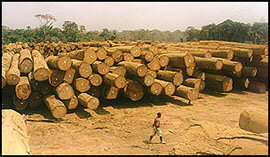 TRADE AND COMMERCE TRADE AND COMMERCE |

The Liberian economy is export-dependent and a few primary products dominate the structure of export. In the 1980s, these primary products were iron ore, rubber and logs, with iron ore accounting for 51.4 % of total exports in 1987. In the same year, total exports were 35.2 % of the GDP.
In the imports sector, the major commodities were machinery and equipment, mineral fuels and lubricant, food and live animals and manufactured goods, with machinery accounting for the dominant share of 23.9 % of total imports.
The total exports in 1987 being 35.2% of GDP, while the total import stood at 26.9% of GDP in the same year, created a positive trade balance of 93.6million USD, according to Ministry of Commerce statistics.
In the 1990s, the performance of foreign trade, however, showed a considerable decline as a result of the adverse impact of the country's civil conflict and also because of the dormancy of the iron ore mining due to the destruction and the substantial capital infusion required for reactivation.
In 1999, export earnings fell significantly to 12.3% of GDP, while the value of imports increased to 38.7%, representing a trade deficit of 108.5million USD.
The leaders in the Liberian export and import trades also changed, with rubber and logs taking over from iron ore and accounting for 64.0% of total exports, while for imports, food and live animals replaced machinery and equipment as the dominant imports, accounting for 35.7 % of total imports.
| Over the first two quarters of the year 2000, the foreign trade structure remained virtually the same as in the previous year, according to records from the Ministry of Commerce and Industry. Unsurprisingly, the characteristics of exports also remained unchanged, with the vast majority of the commodities exported unprocessed.
The lack of diversification in the export trade leaves the economy highly vulnerable to external shocks, such as major fluctuations in world commodity prices.
For the six-month period ending June 2000, the values of exports and imports were 30.7million USD and 82.7million USD respectively, resulting in a trade deficit of 52.0million USD, official statistics show.
The persistent trade deficit experienced since 1997 is financed substantially by international grants and remittances from Liberians abroad, economists say. They suggest that the large and persistent trade deficit must be considered sufficiently serious to merit urgent policy measures to include increasing volume of export and transforming primary commodities into processed and semi-processed products.
This reflects the overriding drive of the government to pursue the value-added approach to export trade in the recent past.
Total merchandise imports for the period January to June 2000 were food and live animals, 36.60%; machinery and transport equipment, 20%; manufactured goods, 14.40%; chemicals and related products, 12.20%; beverages and tobacco, 3.70%; miscellaneous, 6.30% and others, 6.70%.
In 1999, Liberia's major trading partners were the United States, France and Singapore (courtesy Scanship / Umarco: import / export statistics year 2000) |

